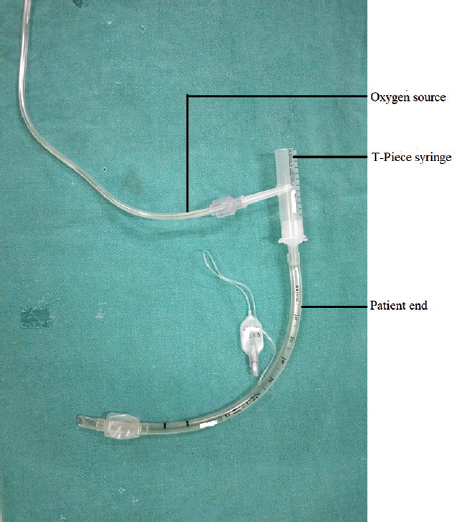Translate this page into:
T-piece made from a 10 ml syringe
*For correspondence: drpallaviahluwalia@yahoo.com
-
Received: ,
This is an open access journal, and articles are distributed under the terms of the Creative Commons Attribution-NonCommercial-ShareAlike 4.0 License, which allows others to remix, tweak, and build upon the work non-commercially, as long as appropriate credit is given and the new creations are licensed under the identical terms.
This article was originally published by Wolters Kluwer - Medknow and was migrated to Scientific Scholar after the change of Publisher.
T-piece is an instrument used in weaning of a patient from ventilator during spontaneous breath trials, and is widely used to identify patients who are ready for extubation. T-shaped tubing connected to an endotracheal tube is used to deliver oxygen therapy in an intubated patient who does not require mechanical ventilation. It provides low-pressure support and high oxygen concentration to the patient. In an emergency situation, (during patient management in triage), in the department of Anaesthesia, Teerthanker Mahaveer University, Moradabad, India, a 10 ml syringe was modified to make an alternative to T-piece, as there was non-availability of T-piece in the emergency room, in August, 2018.
A keyhole was made in the middle of the syringe, the needle cap was cut from the blind end and was inserted in it; oxygen tubing was attached to it, to provide oxygen supplementation (Figure). In our experience, this alternate T-piece (made from a 10 ml syringe) was equally efficient, when compared to the traditional, commercially available T-piece. In certain situations, there is a need to secure airway, for example, in cases of trauma or presence of vomitus in an unconscious patient. In such patients, supplemental oxygen can be provided by attaching this (modified T-piece) to the endotracheal tube as a regular T-piece may not be always available in peripheries or non-operating room locations. This modification is economically viable as the cost of procuring a T-piece can be easily avoided. Thus, this can be a useful alternative in situations where there is non-availability of T-piece in emergency situations or low-resource settings.

- T-piece syringe in the circuit with endotracheal tube at the patient end along with oxygen source.
Knowledge about such easy method to make T-piece from a readily available material (syringe in this case) can improve patient management in rural areas where there is often a scarcity of equipment and devices.
Conflicts of Interest: None.





